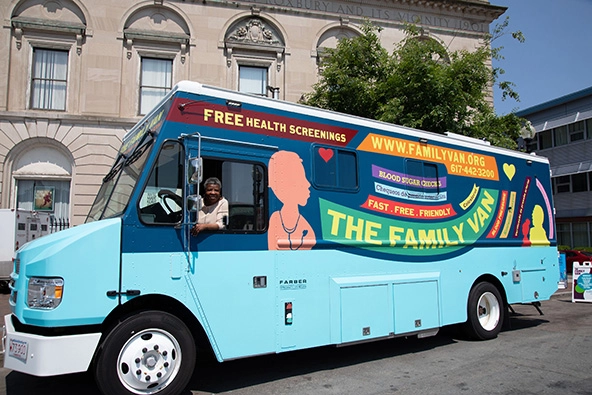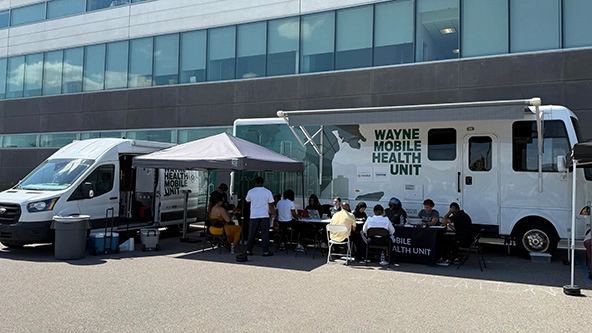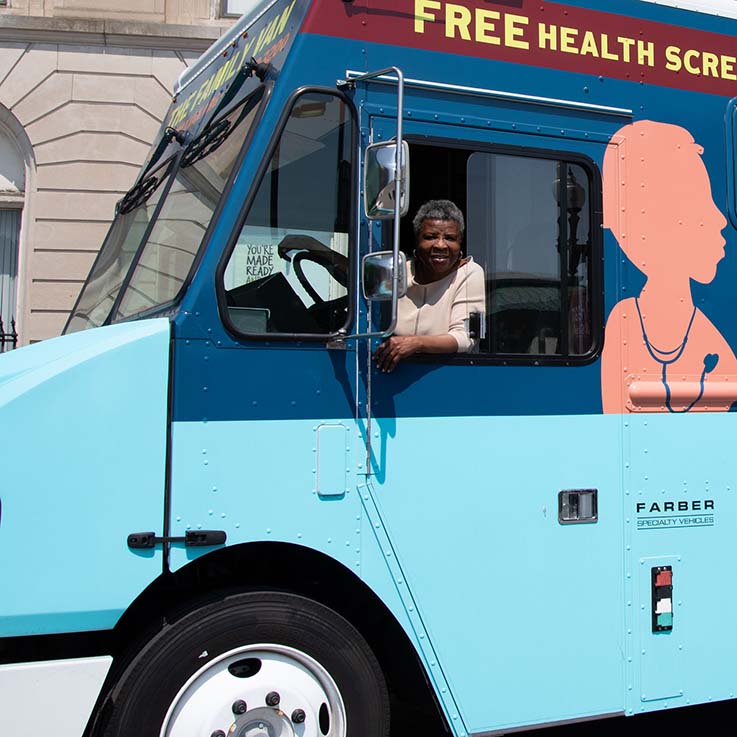
Community health worker Ghislaine “Gigi” Firmin driving The Family Van mobile clinic vehicle in Boston. (Photo by Mim Adkins)
The US health-care system is reaching its breaking point. Individuals, families, employees, employers, and public and private health insurance funders are all spending more for health care every year, with little improvement in the overall health of our communities. The United States has higher maternal and infant death rates than most other high-income countries. Rural and underserved areas have stubbornly high preventable illness and death from heart disease, cancer, and stroke. Recently, we have even seen the rise in outbreaks of measles, a preventable disease, in the underserved parts of many states, with an adult dying in New Mexico and two children dying in Texas this year.
An important part of the solution is expanding mobile health care to address the prevention and distribution problems that are causing the crisis. However, there are barriers to that expansion—reimbursement; regulation, licensing, and credentialing prerequisites; and a lack of data—that must be addressed in the health care system, state by state, for communities to access the care they need.
Why Mobile Health Care
To paraphrase mobile health-care leader Dr. Nancy Oriol, there are two main problems underlying the crisis. First, there is a prevention
problem because the system focuses mostly on expensive disease cures instead of money-saving screening and preventative care. Second, there is a distribution problem: Immobile brick-and-mortar hospitals and offices can’t reach many Americans, and those facilities are struggling. More than 100 hospitals have closed over the past decade, and more are expected to close and reduce services in light of recent cuts to Medicaid. These flaws in the system cause small health problems to grow bigger and much more expensive to treat. We all pay for this in higher medical bills, insurance premiums, and taxes—not to mention the loss of family and friends. It is a bad deal.
Are you enjoying this article? Read more like this, plus SSIR’s full archive of content, when you subscribe.
An expanded mobile health-care sector can address health-care system distribution and prevention problems in the following ways:
Reaching people where they live and work, and adapting to local health priorities. For example, rural Missouri’s Mobile Integrated Healthcare Network employs community paramedics and health workers to make regular home visits to high-risk patients who lack primary care access. They operate vehicles equipped to facilitate care at patients’ homes, even carrying mobile hotspots
to enable telehealth visits for patients who lack internet access.Focusing on preventing illness and delivering essential services for health and quality of life. One example is The Family Van of Boston, which brings preventative screenings and health education to several underserved neighborhoods. Its mobile units of community health workers and volunteers provide screenings for conditions such as hypertension, diabetes, memory loss, and pregnancy. They also offer mental wellness services and connect patients to community resources for employment, health insurance, food assistance, and low-cost dental services. Similarly, in Michigan, the Wayne Health Mobile Unit
operates in underserved communities in Detroit, in southeastern Michigan, and increasingly, across the state. Its staff of registered nurses, medical/research assistants, community health workers, and others provide preventative screenings, behavioral health resources, and primary care and specialist referrals.Achieving real health-care savings. A 2020 study of 96 mobile clinic programs across Texas, North Carolina, Georgia, and Florida found the cost per patient visit to be much less than fixed clinic services. A Harvard study of The Family Van service (mentioned above) found annual savings of up to $36 for every $1 invested compared to emergency department visits. They also reduce the burden on struggling hospitals: A 2023 meta-analysis in the American Journal of Emergency Medicine found an average 44 percent reduction in risk of emergency department visits and a 54 percent reduction of risk of hospital admission. Mobile Health Map estimates that a mobile health unit can prevent up to 600 emergency room visits a year.

A mobile health clinic vehicle from the Wayne Mobile Health Unit in Michigan. (Photo by Phil Levy)
Challenges and the Start of a New Approach
While mobile health care is not new, intentionally scaling mobile health care across states is. It hasn’t been done before. There are a few thousand mobile health care efforts scattered across the country, supported by a mix of funding, primarily from philanthropy. My own organization, the Leon Lowenstein Foundation, has been a funder of organizations like the School-Based Health Alliance, which has centers across the country and resources and tools to help integration with mobile health services. And earlier this year we supported the launch of a national campaign, Driving Health Forward, to convene stakeholders to discuss scaling. However, across states, scaling mobile health care is stymied by many structural barriers, including systemic issues relating to reimbursement; regulation, licensing, and credentialing; and a lack of data.
Reimbursement: Philanthropy and grants are necessary but not sufficient to grow mobile health care. Unfortunately, many health-care payers (insurers, state Medicare authorities, etc.) have traditional fee-for-service models that can have unclear guidance and codes for billing mobile health services, leading to unnecessary claim denials and payment delays. Also, reimbursement rates between payers in a state can vary widely, making mobile health care revenue unpredictable. The solution is state-by-state advocacy and partnership for payment reforms to reduce administrative costs and make mobile health care sustainable. For example, the Wayne Health Mobile Unit worked with an insurer to create billing codes for bundled payments, i.e., a single consolidated payment for a defined set of health services and supplies like treatments, tests, and procedures during an “episode of care” by one or more providers. For a person living with diabetes, the bundled payment would cover a predetermined set of services (i.e., a health risk assessment, insulin, and testing supplies) for this person’s care over a specific period of time. Now, the provider has a more predictable and sustainable cash flow for covering operating costs, and the payer avoids costs from preventable emergencies.Regulation, licensing, and credentialing: Scaling mobile health care requires streamlined regulations and licensing in states and localities. Some jurisdictions only have regulations meant for brick-and-mortar facilities (such as permits, sanitation standards, and access for people with disabilities). Similarly, credentialing requirements may not be adapted for mobile environments and can complicate an otherwise qualified provider’s ability to practice. Also, for mobile health care that crosses state or even county lines, navigating varying regulations and licensing creates substantial burdens that limit flexibility and growth. One example of reform is sparing mobile health care from state certificate of need requirements, i.e., regulatory approvals required for major health-care projects or investments. More than 15 US states have repealed or reduced these requirements because they are costly and burdensome for startup efforts like mobile health clinics. To broaden efforts like this, patient and consumer representatives, clinicians and other health care professionals, mobile health program operators, manufacturers, and other interested parties can use their collective voice and power to make the case for why these changes will benefit their communities and improve access to care.
Lack of data: Mobile health care also needs better collection of and connection to health-care system data to drive impact on health and costs. In addition to more efficient day-to-day referrals and coordination of care, systemically, it would take much of the guesswork out of getting the right care to the right place at the right time. However, sharing electronic health information between different entities can present interoperability challenges. For example, if a mobile provider using a regional health center’s system is not compatible with the local hospital system, it is difficult to measure the impact on hospital costs and community health. Partnerships and collaboration to engage health systems, providers, and other stakeholders are the solution here. Philanthropy can convene, fund, and even point stakeholders to models worth considering. For example, a recent Georgetown University study, funded by the Leon Lowenstein Foundation, highlighted the lack of data on long-term outcomes and cost efficiency to guide thoughtful mobile health care expansion. However, the study noted Mobile Health Map, a national network of mobile clinics, as a promising model of a common platform for some data gathering that could be emulated or expanded. This kind of standardized data can yield much-needed health insights and cost savings for health-care systems.
Looking Ahead
The recent increased flow of grants to expand mobile health care is encouraging. In May, Health Net and the Centene Foundation invested $7.2 million to support a fleet of mobile vans in California. Late last year, the Patterson Family Foundation made a $1.5 million grant to amplify mobile health-care delivery in rural Missouri and Kansas. Additionally, federally qualified health centers are embracing mobile as a complement to traditional delivery of health care: Direct Relief supports a portfolio of $20,000 technical support grants for mobile health care run by the National Association of Community Health Centers. Furthermore, with looming cuts to Medicaid likely to decrease health-care access in rural areas, rural mobile health care could fill those gaps if it is a top priority in individual states’ applications this fall to the $50 billion Rural Health Transformation Program.
But investments like these can easily go to waste if mobile health care does not thrive and scale as a sector. Changing health-care systems requires dedicated, long-term, collaborative commitment. We need sector convenings where mobile health care, philanthropy, state and local government, community organizations, health-care providers, insurers, and equipment providers can gather and partner. State by state, we must forge partnerships and advocate for reducing payment barriers and for preventing barriers in regulation, licensing, and credentialing. We must collaborate to improve data gathering to yield efficiencies and measure long-term impact. It will take all of us to change the US health-care system and expand prevention through mobile health care to save lives.
Support SSIR’s coverage of cross-sector solutions to global challenges.
Help us further the reach of innovative ideas. Donate today.
Read more stories by Andrew Bendheim.

